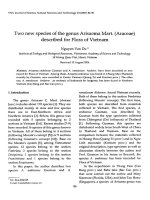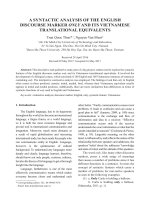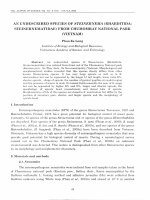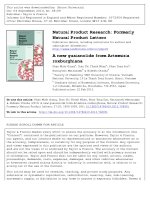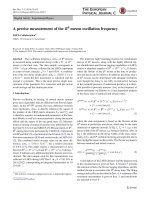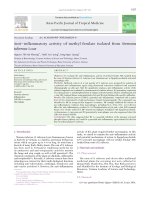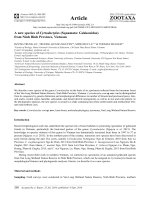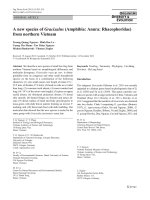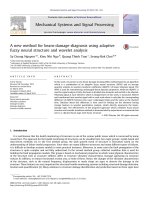DSpace at VNU: A new species of Cyrtodactylus (Squamata: Gekkonidae) from Ninh Binh Province, Vietnam
Bạn đang xem bản rút gọn của tài liệu. Xem và tải ngay bản đầy đủ của tài liệu tại đây (6.44 MB, 15 trang )
Zootaxa 4162 (2): 268–282
/>Copyright © 2016 Magnolia Press
Article
ISSN 1175-5326 (print edition)
ZOOTAXA
ISSN 1175-5334 (online edition)
/> />
A new species of Cyrtodactylus (Squamata: Gekkonidae)
from Ninh Binh Province, Vietnam
DZUNG TRUNG LE1, TRUONG QUANG NGUYEN2,8, MINH DUC LE3,4,5 & THOMAS ZIEGLER6,7
1
Faculty of Biology, Hanoi National University of Education, 136 Xuan Thuy Road, Hanoi, Vietnam.
E-mail:
2
Institute of Ecology and Biological Resources, Vietnam Academy of Science and Technology, 18 Hoang Quoc Viet, Hanoi, Vietnam.
E-mail:
3
Faculty of Environmental Sciences, Hanoi University of Science, Vietnam National University, 334 Nguyen Trai Road, Hanoi,
Vietnam. E-mail:
4
Centre for Natural Resources and Environmental Studies, Hanoi National University, 19 Le Thanh Tong, Hanoi, Vietnam
5
Department of Herpetology, American Museum of Natural History, Central Park West at 79th Street, New York, New York 10024
6
AG Zoologischer Garten Köln, Riehler Strasse 173, D–50735 Cologne, Germany. E–mail:
7
Institute of Zoology, University of Cologne, Zülpicher Strasse 47b, D–50674 Cologne, Germany
8
Corresponding author. E-mail:
Abstract
We describe a new species of the genus Cyrtodactylus on the basis of six specimens collected from the limestone forest
of the Van Long Wetland Nature Reserve, Ninh Binh Province, Vietnam. Cyrtodactylus soni sp. nov. can be distinguished
from its congeners by genetic distinction and morphological differences in number of femoral and precloacal pores, femoral scales, ventral scales, lamellae, subcaudals, and dorsal tubercle arrangement, as well as in size and color pattern. In
the phylogenetic analyses, the new species is nested in a clade containing taxa from northwestern and northcentral Vietnam and northern Laos.
Key words: Cyrtodactylus soni sp. nov., karst forest, molecular phylogeny, taxonomy, Van Long Wetland Nature Reserve
Introduction
Recent herpetological work has underlined the special role of karst habitats in promoting speciation of gekkonid
lizards in Vietnam, particularly the bent-toed geckos of the genus Cyrtodactylus (Nguyen et al. 2015). The
knowledge on species richness of this genus in Vietnam has dramatically increased from three in 1997 to 37 at
present (Nguyen et al. 2015). In the northern part of the country, numerous new species have been discovered in
karst forests during the past five years, namely Cyrtodactylus bichnganae Ngo & Grismer, 2010 from Son La
Province, C. cucphuongensis Ngo & Chan, 2011 from Ninh Binh Province, C. huongsonensis Luu, Nguyen, Do &
Ziegler, 2011 from Hanoi, C. martini Ngo, 2011 from Lai Chau Province, C. bobrovi Nguyen, Le, Pham, Ngo,
Hoang, Pham & Ziegler, 2015, and C. otai Nguyen, Le, Pham, Ngo, Hoang, Pham & Ziegler, 2015 from Hoa Binh
Province.
During recent field work in northern Vietnam, we collected six specimens of an unnamed gekkonid species
from Van Long Wetland Nature Reserve in Ninh Binh Province, which can be assigned to Cyrtodactylus based on
morphological features and phylogenetic analyses. Herein, we describe it as a new species.
Material and methods
Sampling. Field surveys were conducted in Van Long Wetland Nature Reserve, Ninh Binh Province, northern
268 Accepted by A. Bauer: 25 Jul. 2016; published: 9 Sept. 2016
Vietnam, in July and August 2015. Specimens were anaesthetized and fixed in approximately 85% ethanol, then
later transferred to 70% ethanol for permanent storage. Specimens referred to in this paper are deposited in the
collections of the Museum of Biology, Hanoi National University of Education (HNUE), Hanoi; the Institute of
Ecology and Biological Resources (IEBR), Hanoi; the Tay Bac University (TBU), Son La Province; Muséum
d'histoire naturelle, Geneva (MHNG), Switzerland; the Vietnam Forest Museum (VFM), Forest Inventory and
Planning Institute, Hanoi; the Vietnam National Museum of Nature (VNMN), Hanoi; the Vietnam National
University of Forestry (VUF), Hanoi, Vietnam; the Namlik Ecovillage Museum (NEM), Ban That Wang Monh,
Vientiane Province, Laos; the National University of Laos (NUOL), Vientiane, Laos; the Senckenberg
Naturhistorische Sammlungen Dresden, Museum für Tierkunde (MTD), Dresden; and the Zoologisches
Forschungsmuseum Alexander Koenig (ZFMK), Bonn, Germany.
Molecular data and phylogenetic analyses. We sequenced two samples of Cyrtodactylus collected from Van
Long Wetland Nature Reserve and the holotype of C. huongsonensis (IEBR A.2011.3A, see Luu et al. 2011). We
also included all available sequences from members of the C. wayakonei species group (Fig. 1, Table 1). The
species group was defined as clade B in Nguyen et al. (2015). Two species, C. elok Dring and C. pulchellus Gray
(see Grismer et al. 2012), were used as outgroups.
We used the protocols of Le et al. (2006) for DNA extraction, amplification, and sequencing. A fragment of the
mitochondrial gene, cytochrome c oxidase subunit 1 (COI), was amplified using the primer pair VF1-d and VR1-d
(Ivanova et al. 2006). After sequences were aligned by Clustal X v2 (Thompson et al. 1997), data were analyzed
using maximum parsimony (MP) and maximum likelihood (ML) as implemented in PAUP*4.0b10 (Swofford
2001) and Bayesian analysis (BA) as implemented in MrBayes v3.2 (Ronquist et al. 2012). Settings for these
analyses followed Le et al. (2006), except that the number of generations in the Bayesian analysis was increased to
1´107. The optimal model for nucleotide evolution was set to TIM+I+G for ML and combined Bayesian analyses as
selected by Modeltest v3.7 (Posada & Crandall 1998). The cutoff point for the burn-in function was set to 11 in the
Bayesian analysis, as -lnL scores reached stationarity after 11,000 generations in both runs. Nodal support was
evaluated using Bootstrap replication (BP) as estimated in PAUP and posterior probability (PP) in MrBayes v3.2.
Uncorrected pairwise divergences were calculated in PAUP*4.0b10 (Table 2).
Morphological characters. Measurements were taken with a digital caliper to the nearest 0.1 mm.
Abbreviations are as follows: snout-vent length (SVL, from tip of snout to anterior margin of cloaca), tail length
(TaL, from posterior margin of cloaca to tip of tail), head length (HL, from tip of snout to the posterior margin of
the retroarticular), maximum head width (HW), maximum head height (HH, from occiput to underside of jaws),
internarial distance (IND), interorbital distance (IOD), greatest diameter of orbit (OD), snout to eye distance (SE,
from tip of snout to anteriormost point of eyeball), eye to ear distance (EE, from anterior edge of ear opening to
posterior corner of eye), nostril to eye distance (NE, from nostril to anteriormost point of eyeball), ear diameter
(ED, maximum diameter of ear), forearm length (ForeaL, from base of palm to elbow), crus length (CrusL, from
base of heel to knee), trunk length or axilla-groin distance (AG, from posterior edge of forelimb insertion to
anterior edge of hind limb insertion), maximum body width at midbody (BW).
Scale counts were taken using a stereo microscope (Leica M80): supralabials (SL) and infralabials (IL),
counted from the first labial scale to the corner of mouth, nasal scales surrounding nare (N, i.e. nasorostral,
supranasal, postnasals), postrostrals or internasals (IN), ciliaria (CIL, scales on eyelid fringe), postmentals (PM),
granular scales surrounding dorsal tubercles (GST), ventral scales in longitudinal rows at midbody (V) counted
transversely across the center of the abdomen from one ventrolateral fold to the other, number of scales along the
midbody from mental to anterior edge of cloaca (SLB), femoral pores (FP), precloacal pores (PP) or the total
number of femoral and precloacal pores (i.e. the contiguous rows of femoral and precloacal scales bearing pores
combined as a single meristic character referred to as the femoroprecloacal pores), postcloacal tubercles (PAT),
dorsal tubercle rows (TubR, counted transversely across the center of the dorsum from one ventrolateral fold to the
other), enlarged femoral scales (EFS), number of subdigital lamellae on fingers (NSF I–V) and number of
subdigital lamellae on toes (NST I–V) counted from the base of the first phalanx to the claw. Bilateral scale counts
were given as left/right. Other abbreviations are as follows: above sea level (a.s.l.) and nature reserve (NR).
A NEW CYRTODACTYLUS FROM VIETNAM
Zootaxa 4162 (2) © 2016 Magnolia Press ·
269
Results
Phylogenetic analyses
The final matrix consisted of 657 aligned characters, of which 212 are parsimony informative. The alignment
contained no gap. MP analysis of the dataset recovered two most parsimonious trees with 578 steps (CI = 0.58; RI
= 0.76). In the ML analysis, the score of the single best tree found was 3361.12 after 2448 arrangements were tried.
The topology derived from the Bayesian analysis (Fig. 1) is similar to clade B in Nguyen et al. (2015), but C.
bichnganae was supported as the sister taxon to C. huongsonensis + the new species instead of being placed as the
basal taxon of the clade as shown in Nguyen et al. (2015) (Fig. 1). However, both placements received low
statistical support values from all analyses. The new species was recovered as the sister taxon to C. huongsonensis
with high statistical support values from all phylogenetic analyses. These two species were approximately 5.0–
5.5% genetically divergent from each other (Table 1).
TABLE 1. Uncorrected (“p) distance matrix showing percentage pairwise genetic divergence (COI) between new and
closely related species
Species name
1
2
3
1. C. bichnganae
(KT004372)
–
2. C. bobrovi
(KT004367-8)
16.3
–
3. C. cf. martini
(KF929537)
15.8
16.9-17.1 –
4
5
6
7
4. C. huongsonensis 14.5
(KX430034)
15.8
16.0
–
5. C. otai
(KT00370-1)
16.0
3.8
17.8
15.4
–
6. C. puhuensis
(KF929529)
18.9
7.3–7.5
17.8
18.3
7.4
7. Cyrtodactylus
soni sp. nov.
(KX430032-3)
13.4–13.9 16.7–16.9 16.4–16.7 5.0–5.5
8. C. spelaeus
(KP199947-8)
15.2–15.5 9.7–10.0
15.0–15.4 16.5–16.9 11.0–11.3 11.3–11.7 15.4–16.1
9. C. vilaphongi
(KJ817434-5)
15.7
9.3
15.5
10. C. wayakonei
(KJ817438/
KP199950)
14.8
16.6–16.8 6.7–6.9
15.2
8
9
10
–
16.1–16.4 19.1–19.5 –
9.4
10.4
15.7–16.1
16.6–16.9 18.1–18.4 18.2–18.4 17.2–17.7
–
11.7–12.0 –
16.1–16.5 15.8–16.2 –
Cyrtodactylus soni sp. nov.
(Figs. 2–4)
Holotype. HNUE VL.2015.78, adult male, collected on 24 July 2015 by D. T. Le, A. M. Luong, D. T. Pham, and
N. H. Nguyen, in the karst forest near Da Han Village (20o25.067’N, 105o51.467’E, elevation 17 m a.s.l.), Gia Hoa
Commune, within Van Long Wetland Nature Reserve, Gia Vien District, Ninh Binh Province, Vietnam.
Paratypes. IEBR R.2016.4, adult female, HNUE VL.2015.94, adult female, collected on 24 July 2015; IEBR
R.2016.5, adult male, HNUE VL.2015.131, adult female, and HNUE VL.2015.132, adult female, collected on 18
August 2015, the same data as the holotype.
Diagnosis. The new species can be distinguished from other members of the genus Cyrtodactylus from
Indochina by a combination of the following characters: medium size (SVL up to 103 mm); internasal single;
dorsal tubercles in 10–13 irregular rows; ventral scale rows 41–45; lateral skin folds present, without interspersed
270 · Zootaxa 4162 (2) © 2016 Magnolia Press
LE ET AL.
tubercles; precloacal pores 6 or 7 in males, 7 or 8 pitted scales in females, in a continuous row; femoral pores 6–8
on each side in males, separated by 8–11 poreless scales from precloacal pore series; enlarged femoral scales
present; postcloacal spurs 2 or 3; subcaudal scales transversely enlarged; lamellae under toe IV 18–22; dorsal
pattern consisting of a dark nuchal loop, a continuous or partly interrupted neck band, and five or six in part
irregular transverse body bands between limb insertions.
FIGURE 1. Phylogram based on the Bayesian analysis. Number above and below branches are MP/ML bootstrap values and
Bayesian posterior probabilities (>50%), respectively. Asterisk represents 100% value.
Description of holotype. Adult male, snout-vent length (SVL) 89.5 mm; body elongate (AG/SVL 0.44); head
distinct from neck, elongate, depressed (HL/SVL 0.28, HW/HL 0.71, HH/HL 0.44); loreal region concave; snout
long (SE/HL 0.44), round anteriorly, longer than diameter of orbit (OD/SE 0.54); snout scales small, round,
granular; eye large (OD/HL 0.24), pupils vertical, spinous ciliaries 32; ear oval shaped, small (ED/HL 0.08); rostral
wider than high with a medial suture, bordered by first supralabial, nostril, and supranasal on each side; supranasals
separated from each other by two small scales; nares round, surrounded by supranasal, rostral, first supralabial, and
three postnasals; mental triangular, slightly wider than rostral; postmentals two, enlarged, in broad contact
posteriorly, bordered by mental anteriorly, first infralabial laterally, and an enlarged chin scale posteriorly;
supralabials 10/10; infralabials 9/9.
Dorsal scales granular; dorsal tubercles round, conical, present on occipital region and back, each surrounded
by 9 or 10 granular scales; ventral scales smooth, medial scales 2 or 3 times larger than dorsal scales, round,
subimbricate, largest posteriorly, in 41 longitudinal rows at midbody; lateral skin folds distinct without tubercles;
gular region with homogeneous smooth scales; 186 ventral scales between mental and cloacal slit; precloacal
groove absent; enlarged femoral scales present; precloacal pores 6, femoral pores 6 on each side, in distal scale
portion of enlarged femoral scales, separated by 8 poreless scales from precloacal pore series.
Fore and hind limbs moderately slender (ForeaL/SVL 0.17, CrusL/SVL 0.2); forelimbs dorsally covered by
few slightly developed tubercles; hind limb dorsally covered by distinctly developed tubercles; fingers and toes
without distinct webbing; each claw bordered by two scales; subdigital lamellae: finger I 11 (including 2 basally
A NEW CYRTODACTYLUS FROM VIETNAM
Zootaxa 4162 (2) © 2016 Magnolia Press ·
271
broadened lamellae), finger II 14 (4), finger III 15 (4), finger IV 16 (4), finger V 16 (5), toe I 11 (2), toe II 14 (4),
toe III 17 (5), toe IV 18 (6), toe V 19 (7).
Tail regenerated (TaL 70.6 mm); postcloacal spurs 2/2; dorsal tail base with tubercles; subcaudals distinctly
enlarged.
Coloration in life. Ground color light brownish grey; dorsal surface of head with irregular dark markings,
largest at occiput; a dark postocular streak, edged in yellowish white, in contact with nuchal loop; neck with a dark
transverse band; dorsum with five distinct dark transverse bands between limb insertions, edged by yellowish
tubercles; upper surfaces of limbs with dark bands and reticulations; dorsal surface of the regenerated tail with
indistinct transverse bands; gular region cream with indistinct grey marbling; venter cream; ventral surface of the
regenerated tail dark grey with yellow marbling.
Morphological comparisons. We compared the new species with its congeners from Vietnam and
neighbouring countries in mainland Indochina, including Laos, Cambodia, and Thailand based on the examination
of specimens (see Appendix) and data obtained from the literature (Bauer et al. 2002, 2003, 2010; David et al.
2004, 2011; Geissler et al. 2009; Hoang et al. 2007; Kunya et al. 2014, 2015; Luu et al. 2011, 2014, 2015, 2016a,
2016b, 2016c; Nazarov et al. 2008, 2012, 2014; Ngo 2011, 2013; Ngo & Grismer 2010; Ngo & Chan 2011;
Nguyen et al. 2010, 2015; Nguyen et al. 2013, 2014; Panitvong et al. 2014 ; Pauwels & Sumontha 2014; Pauwels
et al. 2013, 2014a, 2014b, 2016; Phung et al. 2014; Schneider et al. 2011, 2014 a, 2014b; Smith 1921; Sumontha et
al. 2015; Ziegler et al. 2010, 2013).
Cyrtodactylus soni sp. nov. has distinctly enlarged subcaudals, which are only slightly or not enlarged in the
following species: C. bidoupimontis Nazarov, Poyarkov, Orlov, Phung, Nguyen, Hoang & Ziegler, C. buchardi
David, Teyni & Ohler, C. bugiamapensis Nazarov, Poyarkov, Orlov, Phung, Nguyen, Hoang & Ziegler, C.
cattienensis Geissler, Nazarov, Orlov, Böhme, Phung, Nguyen & Ziegler, C. cryptus Heidrich, Rösler, Vu, Böhme
& Ziegler, C. cucdongensis Schneider, Phung, Le, Nguyen & Ziegler, C. huynhi Ngo & Bauer, C. irregularis
(Smith), C. otai Nguyen, Le, Pham, Ngo, Hoang, Pham & Ziegler, C. phuocbinhensis Nguyen, Le, Tran, Orlov,
Lathrop, Macculloch, Le, Jin, Nguyen, Nguyen, Hoang, Che, Murphy & Zhang, C. pseudoquadrivirgatus Rösler,
Nguyen, Vu, Ngo & Ziegler, C. quadrivirgatus Taylor, C. ranongensis Sumontha, Pauwels, Panitvong, Kunya &
Grismer, C. taynguyenensis Nguyen, Le, Tran, Orlov, Lathrop, Macculloch, Le, Jin, Nguyen, Nguyen, Hoang, Che,
Murphy & Zhang, C. thuongae Phung, van Schingen, Ziegler & Nguyen, C. vilaphongi Schneider, Nguyen, Le,
Nophaseud, Bonkowski & Ziegler, and C. ziegleri Nazarov, Orlov, Nguyen & Ho.
Cyrtodactylus soni sp. nov. has enlarged femoral scales which are absent in C. angularis (Smith), C.
badenensis Nguyen, Orlov & Darevsky, C. bobrovi Nguyen, Le, Pham, Ngo, Hoang, Pham & Ziegler, C. buchardi,
C. chauquangensis Hoang, Orlov, Ananjeva, Johns, Hoang & Dau, C. cryptus, C. grismeri Ngo, C. nigriocularis
Nguyen, Orlov & Darevsky, C. otai, C. pageli Schneider, Nguyen, Schmitz, Kingsada, Auer & Ziegler, C.
pseudoquadrivirgatus, C. sumonthai Bauer, Pauwels & Chanhome, C. taynguyenensis, C. vilaphongi, and C.
wayakonei Nguyen, Kingsada, Rösler, Auer & Ziegler.
Cyrtodactylus soni sp. nov. has more femoral and precloacal pores in males (6–7+6–7+6–8) than the following
species: C. angularis (3), C. condorensis (Smith) (0–4), C. kunyai Pauwels, Sumontha, Keeratikiat & Phanamphon
(5+3+6), C. martini (4), C. nigriocularis (0–2), C. oldhami (1–4), C. pageli (4), C. phetchaburiensis Pauwels,
Sumontha & Bauer (0+5+0), C. quadrivirgatus (4), C. sumonthai (2), C. sanook Pauwels, Sumontha, Latinne &
Grismer (3 or 4), C. sayiok Panitvong, Sumontha, Tunprasert & Pauwels (0+5+0), C. takouensis Ngo & Bauer (3 or
4), and absent in C. badenensis, C. cucphuongensis, C. eisenmanae Ngo, C. grismeri, and C. ranongensis.
Cyrtodactylus soni sp. nov. has more femoral and precloacal pores (or pitted scales) in females (6–8+7–8+5–6)
than the following species: C. angularis (3), C. cucdongensis (4–6), C. dumnuii Bauer, Kunya, Sumontha,
Niyomwan, Pauwels, Chanhome & Kunya (0+0–7+0), C. irregularis (0–6), C. pageli (4), C. quadrivirgatus (4);
femoral and precloacal pores (or pitted scales) are absent in the females of C. auribalteatus Sumontha, Panitvong
& Deein, C. badenensis, C. bidoupimontis, C. bobrovi, C. buchardi, C. caovansungi Orlov, Nguyen, Nazarov,
Ananjeva & Nguyen, C. cattienensis, C. condorensis, C. cryptus, C. eisenmanae, C. grismeri, C. interdigitalis
Ulber, C. jarujini Ulber, C. martini, C. multiporus Nazarov, Poyarkov, Orlov, Nguyen, Milto, Martynov,
Konstantinov & Chulisov, C. nigriocularis, C. otai, C. phuocbinhensis, C. sanook, C. soudthichaki Luu, Calame,
Nguyen, Bonkowski & Ziegler, C. spelaeus Nazarov, Poyarkov, Orlov, Nguyen, Milto, Martynov, Konstantinov &
Chulisov, C. sumonthai, C. takouensis, C. taynguyenensis, C. thuongae, C. thirakhupti, C. vilaphongi, and C.
yangbayensis Ngo & Chan.
272 · Zootaxa 4162 (2) © 2016 Magnolia Press
LE ET AL.
FIGURE 2. The male holotype (HNUE VL.2015.78) of Cyrtodactylus soni sp. nov. in life (A: Dorsal view, B: Ventral view).
Photo D. T. Le.
A NEW CYRTODACTYLUS FROM VIETNAM
Zootaxa 4162 (2) © 2016 Magnolia Press ·
273
FIGURE 3. Cloacal (A) and femoral (B) regions of the holotype (HNUE VL.2015.78) of Cyrtodactylus soni sp. nov. in
preservative. Photo D. T. Le.
274 · Zootaxa 4162 (2) © 2016 Magnolia Press
LE ET AL.
FIGURE 4. Female paratype (IEBR R.2016.4) of Cyrtodactylus soni sp. nov. in life: A) Dorsal view and B) Ventral view.
Photo D. T. Le.
A NEW CYRTODACTYLUS FROM VIETNAM
Zootaxa 4162 (2) © 2016 Magnolia Press ·
275
TABLE 2. Measurements (in mm) and scalation of Cyrtodactylus soni sp. nov. from Ninh Binh Province, Vietnam (M =
male, F = female, * = regenerated or broken tail, min = minimum, max = maximum, other abbreviations defined in the
text).
HNUE
VL.2015.78
IEBR
IEBR
A.2016.5 A.2016.4
HNUE
VL.2015.94
HNUE
VL.2015.131
HNUE
VL.2015.132
Min–Max
(n=6)
Sex
M
M
F
F
F
F
SVL
89.5
89.2
103
88.7
89.5
98.5
88.7–103
TaL
70.6*
82.8*
79.8*
107.8
112
113
70.6–113
HL
25.2
25.1
27.6
25.5
24.6
28
24.6–28
HW
17.8
18.7
19
17.3
17.7
19.3
17.3–19.3
HH
11.2
11
11
10
10
11.1
10–11.2
OD
6.1
6.4
6
5.7
5.3
6.3
5.3–6.4
SE
11.2
10.7
11.6
10.9
10
11.7
10–11.7
EE
8.3
7
8.6
7.9
7.5
8.4
7–8.6
NE
8.7
8.4
8.7
8.8
8.3
9.1
8.3–9.1
ED
1.9
1.8
2.1
2.2
2
1.9
1.8–2.2
ForeaL
15
13.8
15.6
14.8
13.9
16.3
13.8–16.3
CrusL
17.5
17.2
18.8
17.2
16.7
19.5
16.7–19.5
AG
39.8
36
47.4
37.9
38.8
42.2
36–47.4
BW
17
16.2
18
16.3
16.8
19
16.2–19
IND
3.8
3.2
3.5
2.9
3.2
3.3
2.9–3.8
IOD
6.8
7.4
6
7.4
6.7
7.5
6–7.5
SPL
10/10
11/10
13/13
12/12
12/11
11/11
10–13
IFL
9/9
10/9
9/10
10/10
9/10
9/9
9–10
N
5/5
5/4
4/4
4/4
4/4
3/3
3–5
IN
1
1
1
1
1
1
1
CIL
32
32
33
34
31
33
31–34
PM
2
2
2
2
2
2
2
GST
9 or 10
9–11
9 or 10
9–11
9–10
9–11
9–11
V
41
42
45
45
44
43
41–45
SLB
186
188
203
202
209
212
186–212
FP
6/6
7/8
6/6
8/6
6/5
8/6
5–8
PP
6
7
7 (pitted scales)
8 (pitted scales)
7 (pitted scales)
7 (pitted scales)
6–8
PAT
2/2
3/3
3/2
2/2
2/3
2/3
2–3
TubR
10
13
10
10
13
11
10–13
EFS
8/8
8/9
8/8
9/9
11/11
9/10
8–11
I
2+9
3+10
3+10
3+8
2+10
2+10
11–13
II
4+10
5+12
5+12
5+9
4+13
5+11
14–17
III
4+11
5+13
5+13
5+12
5+14
5+12
15–19
IV
4+12
5+14
5+10
5+10
5+14
6+12
15–19
V
5+11
4+11
6+12
4+11
4+12
4+11
15–18
2+9
2+9
3+12
2+10
2+10
2+10
11–15
NSF
NST
I
II
4+10
5+13
5+12
5+12
5+13
5+12
14–18
III
5+12
6+14
7+14
5+14
5+15
7+12
19–21
IV
6+12
7+13
9+13
9+12
7+15
7+13
18–22
V
7+12
7+14
7+15
8+14
7+16
7+14
19–23
276 · Zootaxa 4162 (2) © 2016 Magnolia Press
LE ET AL.
FIGURE 5. Map showing the type locality of Cyrtodactylus soni sp. nov. (red circle) in Van Long Wetland Nature Reserve,
Ninh Binh Province, Vietnam.
Cyrtodactylus soni sp. nov. differs from the following species by having fewer femoral and precloacal pores in
males (6–7+6–7+6–8): C. astrum Grismer, Wood, Quah, Anuar, Muin, Sumontha, Ahmad, Bauer, Wangkulangkul,
Grismer & Pauwels (31–38), C. bansocensis Luu, Nguyen, Le, Bonkowski & Ziegler (34), C. calamei Luu,
Bonkowski, Nguyen, Le, Schneider, Ngo & Ziegler (35–39), C. chanhomeae Bauer, Sumontha & Pauwels (32), C.
darevskii Nazarov, Poyarkov, Orlov, Nguyen, Milto, Martynov, Konstantinov & Chulisov (38–44), C. erythrops
Bauer, Kunya, Sumontha, Niyomwan, Panitvong, Pauwels, Chanhome & Kunya (10+9+9), C. hinnamnoensis Luu,
Bonkowski, Nguyen, Le, Schneider, Ngo & Ziegler (36–44), C. jaegeri Luu, Calame, Bonkowski, Nguyen &
Ziegler (44), C. jarujini (52–54), C. khammouanensis Nazarov, Poyarkov, Orlov, Nguyen, Milto, Martynov,
Konstantinov & Chulisov (40–44), C. lekaguli Grismer, Wood, Quah, Anuar, Muin, Sumontha, Ahmad, Bauer,
Wangkulangkul, Grismer & Pauwels (31–41), C. lomyenensis Ngo & Pauwels (39–40), C. multiporus (58–60), C.
phongnhakebangensis Ziegler, Rösler, Herrmann & Vu (32–42), C. rufford Luu, Calame, Nguyen, Le, Bonkowski
& Ziegler (42–43), C. sommerladi Luu, Bonkowski, Nguyen, Le, Schneider, Ngo & Ziegler (20–26), and C.
soudthichaki (29).
Cyrtodactylus soni sp. nov. has a dorsum with banded color pattern, which is blotched in C. brevipalmatus
(Smith), C. buchardi, C. bugiamapensis, C. erythrops, C. irregularis, C. jarujini, C. phetchaburiensis, C.
phuocbinhensis, C. pseudoquadrivirgatus, C. taynguyenensis, C. teyniei David, Nguyen, Schneider & Ziegler, and
C. thuongae; the dorsum is uniformly brown in C. nigriocularis and striped in C. oldhami, C. quadrivirgatus, and
C. ranongensis.
Cyrtodactylus soni sp. nov. differs from C. kingsadai Ziegler, Phung, Le & Nguyen by having fewer dorsal
tubercle rows (10–13 vs. 17–23 in C. kingsadai).
Cyrtodactylus soni sp. nov. differs from the following species by having more ventral scale rows (41–45): C.
badenensis (25–29), C. bichnganae (30–31), C. buchardi (30), C. chanhomeae (36–38), C. chauquangensis (36–
38), C. doisuthep Kunya, Panmongkol, Pauwels, Sumontha, Meewasana, Bunkhwamdi & Dangsri (29–35), C.
erythrops (28), C. grismeri (33–38), C. inthanon Kunya, Sumontha, Panitvong, Dongkumfu, Sirisamphan &
Pauwels (29–34), C. jaegeri (31–32), C. jarujini (32–38), C. khammouanensis (32–38), C. khelangensis Pauwels,
A NEW CYRTODACTYLUS FROM VIETNAM
Zootaxa 4162 (2) © 2016 Magnolia Press ·
277
FIGURE 6. Habitat of Cyrtodactylus soni sp. nov. in Van Long Wetland Nature Reserve, Ninh Binh Province, Vietnam. Photo:
D. T. Le.
278 · Zootaxa 4162 (2) © 2016 Magnolia Press
LE ET AL.
Sumontha, Panitvong & Varaguttanonda (32–35), C. lomyenensis (35–36), C. multiporus (30–38), C. oldhami (34–
38), C. puhuensis Nguyen, Yang, Le, Nguyen, Orlov, Hoang, Nguyen, Jin, Rao, Hoang, Che, Murphy & Zhang
(36), C. rufford (27–29), C. sanook (27–28), C. soudthichaki (32–33), C. spelaeus (36–39), C. sumonthai (33–36),
C. teyniei (38), C. tigroides (34), C. vilaphongi (34–36), C. wayakonei (31–35), and C. ziegleri (33–39).
Morphologically, Cyrtodactylus soni sp. nov. is most similar to C. huongsonensis but it differs from the latter
by having fewer femoral and precloacal pores (6–7+6–7+6–8 in males vs. 10+6+7 in C. huongsonensis) and more
spinous ciliaries (31–33 vs. 26–28 in C. huongsonensis).
Sexual dimorphism and variation. The females differ from the males in the absence of hemipenial swellings
at the tail base. Three female paratypes have complete tails with distinctly enlarged subcaudals. For other
morphological characters see Table 2.
Distribution. Cyrtodactylus soni sp. nov. is currently known only from the type locality, Van Long Wetland
Nature Reserve, in Ninh Binh Province, Vietnam (Fig. 5).
Ecological notes. Specimens were found at night between 18:30 and 21:00, on limestone cliffs and in rock
crevices, approximately 0.3–1.5 m above the ground, at elevations between 17–28 m a.s.l. The surrounding habitat
consisted of secondary karst forest of medium and small hardwoods mixed with shrubs and vines (Fig. 6). Air
temperature ranged from 25 to 32.1oC and relative humidity was 70–90%.
Etymology. We name this new species in honor of our colleague and friend, Assoc. Prof. Dr. Son Lan Hung
Nguyen, Faculty of Biology, Hanoi National University of Education, Vietnam, in recognition of his support of our
research and conservation work in Vietnam. As common names we suggest Son’s Bent-toed Gecko (English) and
Thạch sùng ngón sơn (Vietnamese).
Discussion
The phylogenetic analyses showed that C. soni together with C. huongsonensis form an independent and wellsupported clade within the C. wayakonei species group (sensu Nguyen et al. 2015; Luu et al. 2016a, 2016b, 2016c).
Although C. bichnganae was also clustered with the clade, its relationship with the other two species was only
weakly corroborated by all analyses. Biogeographically, C. soni and C. huongsonensis are distributed in the same
mountain range southeast of Hanoi. The localities of the two species are about 30 km apart from each other. A
similar level of species richness has been found in other groups of Cyrtodactylus in Vietnam and Laos (Nguyen et
al. 2015, Luu et al. 2014, 2016b, 2016c). It is therefore important to continue taxonomic research in the genus
because it likely harbors a high level of undescribed diversity, especially in karst habitats (Luu et al. 2016a).
Acknowledgements
We are grateful to the directorates of the Forest Protection Department of Ninh Binh Province, and Van Long
Wetland Nature Reserve for support of our field work and issuing relevant permits. D. T. Le thanks A.M. Luong,
D.T. Pham (Hanoi) and staff of Van Long Wetland Nature Reserve for their assistance in the field. We thank D.T.
Pham and H. T. Ngo (Hanoi) for laboratory assistance, E. Sterling (New York) and K. Koy (Berkeley) for providing
the map. Many thanks to S.N. Nguyen (Ho Chi Minh City), O.S.G. Pauwels (Brussels) and A. M. Bauer (Villanova)
for their helpful comments. For the fruitful cooperation within joint biodiversity research and conservation projects
we cordially thank T. H. Tran (IEBR, Hanoi), T. Pagel and C. Landsberg (Cologne Zoo). This research is funded by
the Vietnam National Foundation for Science and Technology Development (NAFOSTED) under grant number
106-NN.05-2014.34 and Cologne Zoo. Equipment was funded by the Alexander von Humboldt Foundation (VIE
1143441).
References
Bauer, A.M., Kunya, K., Sumontha, M., Niyomwan, P., Pauwels, O.S.G., Chanhome, L. & Kunya, T. (2010) Cyrtodactylus
dumnuii (Squamata: Gekkonidae), a new cave-dwelling gecko from Chiang Mai Province, Thailand. Zootaxa, 2570, 41–
50.
A NEW CYRTODACTYLUS FROM VIETNAM
Zootaxa 4162 (2) © 2016 Magnolia Press ·
279
Bauer, A.M., Pauwels, O.S.G. & Chanhome, L. (2002) A new species of cave-dwelling Cyrtodactylus (Squamata: Gekkonidae)
from Thailand. The Natural History Journal of Chulalongkorn University, 2, 19–29.
Bauer, A.M., Sumontha, M. & Pauwels, O.S.G. (2003) Two new species of Cyrtodactylus (Reptilia: Squamata: Gekkonidae)
from Thailand. Zootaxa, 376, 1–18.
David, P., Nguyen, T.Q., Schneider, N. & Ziegler, T. (2011) A new species of the genus Cyrtodactylus Gray, 1827 from central
Laos (Squamata: Gekkonidae). Zootaxa, 2833, 29–40.
David, P., Teyni, A. & Ohler, A. (2004) A new species of Cyrtodactylus Gray 1827 (Reptilia: Squamata: Gekkonidae) from
southern Laos. The Raffles Bulletin of Zoology, 52, 621–627.
Geissler, P., Nazarov, R., Orlov, N.L., Böhme, W., Phung, T.M., Nguyen, T.Q. & Ziegler, T. (2009) A new species of the
Cyrtodactylus irregularis complex (Squamata: Gekkonidae) from southern Vietnam. Zootaxa, 2161, 20–32.
Grismer, L.L., Wood, P.L. Jr, Quah, E.S.H., Anuar, S., Muin, A., Sumontha, M., Ahmad, N., Bauer, A.M., Wangkulangkul, S.,
Grismer, J.L. & Pauwels, O.S.G. (2012) A phylogeny and taxonomy of the Thai-Malay Peninsula Bent-toed Geckos of the
Cyrtodactylus pulchellus complex (Squamata: Gekkonidae): combined morphological and molecular analyses with
descriptions of seven new species. Zootaxa, 3520, 1–55.
Hoang, Q.X., Orlov, N.L., Ananjeva, N.B., Johns, A.G., Hoang, T.N. & Dau, V.Q. (2007) Description of a new species of the
genus Cyrtodactylus Gray, 1827 (Squamata: Sauria: Gekkonidae) from the karst of North Central Vietnam. Russian
Journal of Herpetology, 14, 98–106.
Ivanova, N.V., de Waard, J. & Hebert, P.D.N. (2006) An inexpensive, automation-friendly protocol for recovering high-quality
DNA. Molecular Ecology Notes, 6, 998–1002.
/>Kunya, K., Panmongkol, A., Pauwels, O.S.G., Sumontha, M., Meewasana, J., Bunkhwamdi, W. & Dangsri, S. (2014) A new
forest-dwelling Bent-toed Gecko (Squamata: Gekkonidae: Cyrtodactylus) from Doi Suthep, Chiang Mai Province,
northern Thailand. Zootaxa, 3811 (2), 251–261.
/>Kunya, K., Sumontha, M., Panitvong, N., Dongkumfu, W., Sirisamphan, T. & Pauwels, O.S.G. (2015) A new forest-dwelling
Bent-toed Gecko (Squamata: Gekkonidae: Cyrtodactylus) from Doi Inthanon, Chiang Mai Province, northern Thailand.
Zootaxa, 3905 (4), 573–584.
/>Le, M., Raxworthy, C.J., McCord, W.P. & Mertz, L. (2006) A molecular phylogeny of tortoises (Testudines: Testudinidae)
based on mitochondrial and nuclear genes. Molecular Phylogenetics and Evolution, 40, 517−531.
/>Luu, V.Q., Bonkowski, M., Nguyen, T.Q., Le, M.D., Schneider, N., Ngo, H.T. & Ziegler, T. (2016a) Evolution in karst massifs:
Cryptic diversity among bent-toed geckos along the Truong Son Range with descriptions of three new species and one new
country record from Laos. Zootaxa, 4107 (2), 101−140.
/>Luu, V.Q., Calame, T., Bonkowski, M., Nguyen, T.Q. & Ziegler, T. (2014) A new species of Cyrtodactylus (Squamata:
Gekkonidae) from Khammouane Province, Laos. Zootaxa, 3760 (1), 54−66.
/>Luu, V.Q., Calame, T., Nguyen, T.Q., Bonkowski, M. & Ziegler, T. (2015) A new species of Cyrtodactylus (Squamata:
Gekkonidae) from the limestone forest of Khammouane Province, central Laos. Zootaxa, 4058 (2), 388−402.
/>Luu, V.Q., Calame, T., Nguyen, T.Q., Le, M.D., Bonkowski, M. & Ziegler, T. (2016b) Cyrtodactylus rufford, a new cavedwelling Bent-toed Gecko (Squamata: Gekkonidae) from Khammouane Province, central Laos. Zootaxa, 4067 (2),
185−199.
/>Luu, V.Q., Nguyen, T.Q., Do, H.Q. & Ziegler, T. (2011) A new Cyrtodactylus (Squamata: Gekkonidae) from Huong Son
limestone forest, Hanoi, northern Vietnam. Zootaxa, 3129, 39–50.
Luu, V.Q., Nguyen, T.Q., Le, M.D., Bonkowski, M. & Ziegler, T. (2016c) A new species of karst-dwelling Bent-toed Gecko
(Squamata: Gekkonidae) from Khammouane Province, central Laos. Zootaxa, 4079 (1), 87−102.
/>Nazarov, R.A., Orlov, N.L., Nguyen, S.N. & Ho, C.T. (2008) Taxonomy of naked-toe geckos Cyrtodactylus irregularis
complex of South Vietnam and description of a new species from Chu Yang Sin Natural Park (Krong Bong District, Dac
Lac Province), Vietnam. Russian Journal of Herpetology, 15, 141–156.
Nazarov, R.A., Poyarkov, N.A., Orlov, N.L., Nguyen, S.N., Milto, K.D., Martynov, A.A., Konstantinov, E.L. & Chulisov, A.S.
(2014) A review of genus Cyrtodactylus (Reptilia: Sauria: Gekkonidae) in fauna of Laos with description of four new
species. Proceedings of the Zoological Institute, RAS, 318, 391–423.
Nazarov, R., Poyarkov, N.A., Orlov, N.I., Phung, T.M., Nguyen, T.T., Hoang, D.M. & Ziegler, T. (2012) Two new cryptic
species of the Cyrtodactylus irregularis complex (Squamata: Gekkonidae) from southern Vietnam. Zootaxa, 3302, 1–24.
Ngo, T.V. (2011) Cyrtodactylus martini, another new karst-dwelling Cyrtodactylus Gray, 1827 (Squamata: Gekkonidae) from
Northwestern Vietnam. Zootaxa, 2834, 33–46.
Ngo, T.V. (2013) Cyrtodactylus dati, a new forest dwelling Bent-toed Gecko (Squamata: Gekkonidae) from southern Vietnam.
280 · Zootaxa 4162 (2) © 2016 Magnolia Press
LE ET AL.
Zootaxa, 3616 (2), 151–164.
/>Ngo, T.V. & Chan, K.O. (2011) A new karstic cave-dwelling Cyrtodactylus Gray (Squamata: Gekkonidae) from northern
Vietnam. Zootaxa, 3125, 51–63.
Ngo, T.V. & Grismer, L.L (2010) A new karst dwelling Cyrtodactylus (Squamata: Gekkonidae) from Son La Province,
northwestern Vietnam. Hamadryad, 35, 84–95.
Nguyen, S.N., Le, N.T.T., Tran, D.T.A., Orlov, N.L., Lathrop, A., Macculloch, R.D., Le, D.T.T., Jin, J.-Q., Nguyen, L.T.,
Nguyen, T.T., Hoang, D.D., Che, J., Murphy, R.W. & Zhang, Y.-P. (2013) Phylogeny of the Cyrtodactylus irregularis
species complex (Squamata: Gekkonidae) from Vietnam with the description of two new species. Zootaxa, 3737 (4), 399–
414.
/>Nguyen, S.N., Yang, J.-X., Le, N.T.T., Nguyen, L.T., Orlov, N.L., Hoang, C.V., Nguyen, T.Q., Jin, J.-Q., Rao, D.-Q., Hoang,
T.N., Che, J., Murphy, R.W. & Zhang, Y.-P. (2014) DNA barcoding of Vietnamese Bent-toed Geckos (Squamata:
Gekkonidae: Cyrtodactylus) and the description of a new species. Zootaxa, 3784 (1), 48–66.
/>Nguyen, T.Q., Kingsada, P., Rösler, H., Auer, M. & Ziegler, T. (2010) A new species of Cyrtodactylus (Squamata: Gekkonidae)
from northern Laos. Zootaxa, 2652, 1–16.
Nguyen, T.Q., Le, M.D., Pham, A.V., Ngo, H.N., Hoang, C.V., Pham, C.T. & Ziegler, T. (2015) Two new species of
Cyrtodactylus (Squamata: Gekkonidae) from the karst forest of Hoa Binh Province, Vietnam. Zootaxa, 3985 (3), 375–390.
/>Panitvong, N., Sumontha, M., Tunprasert, J. & Pauwels, O.S.G. (2014) Cyrtodactylus saiyok sp. nov., a new dry evergreen
forest-dwelling Bent-toed Gecko (Squamata: Gekkonidae) from Kanchanaburi Province, western Thailand. Zootaxa, 3869
(1), 64–74.
/>Pauwels, O.S.G. & Sumontha, M. (2014) Cyrtodactylus samroiyot, a new limestone-dwelling Bent–toed Gecko (Squamata:
Gekkonidae) from Prachuap Khiri Khan Province, peninsular Thailand. Zootaxa, 3755 (6), 573–583.
/>Pauwels, O.S.G., Sumontha, M. & Bauer, A.M. (2016) A new Bent-toed Gecko (Squamata: Gekkonidae: Cyrtodactylus) from
Phetchaburi Province, Thailand. Zootaxa, 4088 (3), 409–419.
/>Pauwels, O.S.G., Sumontha, M., Keeratikiat, K. & Phanamphon, E. (2014a) Cyrtodactylus kunyai (Squamata: Gekkonidae), a
new cave-dwelling Bent-toed Gecko from Loei Province, northeastern Thailand. Zootaxa, 3821 (2), 253–264.
/>Pauwels, O.S.G., Sumontha, M., Latinne, A. & Grismer, L.L. (2013) Cyrtodactylus sanook (Squamata: Gekkonidae), a new
cave-dwelling gecko from Chumphon Province, southern Thailand. Zootaxa, 3635 (3), 275–285.
/>Pauwels, O.S.G., Sumontha, M., Panitvong, N. & Varaguttanonda, V. (2014b) Cyrtodactylus khelangensis, a new cave-dwelling
Bent-toed Gecko (Squamata: Gekkonidae) from Lampang Province, northern Thailand. Zootaxa, 3755 (6), 584–594.
/>Phung, T.M., van Schingen, M., Ziegler, T. & Nguyen, T.Q. (2014) A third new Cyrtodactylus (Squamata: Gekkonidae) from
Ba Den Mountain, Tay Ninh Province, southern Vietnam. Zootaxa, 3764 (3), 347−363.
/>Posada, D. & Crandall, K.A. (1998) MODELTEST: testing the model of DNA substitution. Bioinformatics, 14, 817−818.
/>Ronquist, F., Teslenko, M., van der Mark, P., Ayres, D.L., Darling, A., Höhna, S., Larget, B., Liu, L., Suchard, M.A. &
Huelsenbeck, J.P. (2012) MrBayes 3.2: efficient Bayesian phylogenetic inference and model choice across a large model
space. Systematic Biology, 61, 539−542.
/>Schneider, N., Nguyen, T.Q., Le, M.D., Nophaseud, L., Bonkowski, M. & Ziegler, T. (2014a) A new species of Cyrtodactylus
(Squamata: Gekkonidae) from the karst forest of northern Laos. Zootaxa, 3835 (1), 80–96.
/>Schneider, N., Nguyen, T.Q., Schmitz, A., Kingsada, P., Auer, M. & Ziegler, T. (2011) A new species of karst dwelling
Cyrtodactylus (Squamata: Gekkonidae) from northwestern Laos. Zootaxa, 2930, 1–21.
Schneider, N., Phung, T.M., Le, M.D., Nguyen, T.Q. & Ziegler, T. (2014b) A new Cyrtodactylus (Squamata: Gekkonidae) from
Khanh Hoa Province, southern Vietnam. Zootaxa, 3785 (4), 518–532.
/>Smith, M.A. (1920) Reptiles and batrachians collected on Pulo Condore. Journal of Natural History Society of Siam, 4, 93–97.
Sumontha, M., Pauwels, O.S.G., Panitvong, N., Kunya, K. & Grismer, L.L. (2015) A new lowland forest Bent-toed Gecko
(Squamata: Gekkonidae: Cyrtodactylus) from Ranong Province, peninsular Thailand. Zootaxa, 3911 (1), 106–118.
/>Swofford, D.L. (2001) PAUP*. Phylogenetic Analysis Using Parsimony (* and Other Methods), version 4. Sinauer Associates,
A NEW CYRTODACTYLUS FROM VIETNAM
Zootaxa 4162 (2) © 2016 Magnolia Press ·
281
Sunderland, Massachusetts.
Thompson, J.D., Gibson, T.J., Plewniak, F., Jeanmougin, F. & Higgins, D.G. (1997) The ClustalX windows interface: Flexible
strategies for multiple sequence alignment aided by quality analysis tools. Nucleic Acids Research, 25, 4876−4882.
Ziegler, T., Nazarov, R., Orlov, N., Nguyen, T.Q., Vu, T.N., Dang, K.N., Dinh, T.H. & Schmitz, A. (2010) A third new
Cyrtodactylus (Squamata: Gekkonidae) from Phong Nha – Ke Bang National Park, Vietnam. Zootaxa, 2413, 20–36.
Ziegler, T., Phung, T.M., Le, M.D. & Nguyen, T.Q. (2013) A new Cyrtodactylus (Squamata: Gekkonidae) from Phu Yen
Province, southern Vietnam. Zootaxa, 3686 (4), 432–446.
/>
APPENDIX. Comparative specimens examined.
Cyrtodactylus bichnganae. Vietnam: Son La: Son La City: TBU PAT.250, TBU NT.2014.01.
C. bobrovi. Vietnam: Hoa Binh: Ngoc Son—Ngo Luong NR: IEBR A.2015.29 (holotype), IEBR A.2015.30, VFM 2015.1,
VNMN A.2015.61 (paratypes).
C. jaegeri. Laos: Khammouane: Thakhek: IEBR A.2013.55 (holotype), NUOL R-2013.1 (paratype), VFU TK.914.
C. huongsonensis. Vietnam: Hanoi: Huong Son: IEBR A.2011.3 (holotype), ZFMK 92293 (paratype).
C. lomyenensis: Laos: Khammouane: Phou Hin Boun: IEBR KM2012.52, KM2012.54, KM2012.57.
C. otai. Vietnam: Hoa Binh: Hang Kia—Pa Co NR: IEBR A.2015.26 (holotype), IEBR A.2015.27–28, ZFMK 96721, VNMN
A.2015.60 (paratypes).
C. pageli. Laos: Vientiane Province: Vang Vieng: IEBR A.2010.36 (holotype), IEBR A.2010.37, MTD 48025, MHNG
2723.91, NUOL 2010.3–2010.7, ZFMK 91827 (paratypes).
C. roesleri. Vietnam: Quang Binh Province: Phong Nha—Ke Bang: ZFMK 89377 (holotype), IEBR A.0932, MHNG 2713.79,
VNUH 220509, ZFMK 86433, 89378 (paratypes).
C. teyniei. Laos: Borikhamxay Province: near Ban Na Hin: NEM 0095 (holotype); Khammouane Province: Ban Na Than:
IEBR KM.2012.14–15.
C. vilaphongi. Laos: Luang Prabang: IEBR A.2013.103 (holotype), NUOL R-2013.5 (paratype).
C. wayakonei. Laos: Luang Nam Tha: Vieng Phoukha: IEBR A.2010.01 (holotype), ZFMK 91016, MTD 47731, NUOL 2010.1
(paratypes).
282 · Zootaxa 4162 (2) © 2016 Magnolia Press
LE ET AL.
